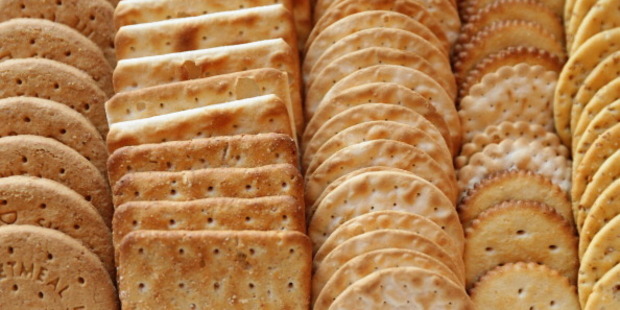
Kiwis who consider crackers to be a healthy snack may be shocked to hear some of their crunchy favourites are higher in salt and fat than certain potato chips.
A survey of 90 types of cracker by Consumer New Zealand found that only one achieved five out of five stars when using the Australian Department of Health's rating system.
At the bottom of the group, the survey found two cracker varieties only achieved half a star each, due to them containing high levels of salt and saturated fat.
The variety that ranked the highest - and therefore healthiest - in the survey was Ryvita's Wholegrain Rye Crispbread with Pumpkin Seeds. A 100 gram serving of the cracker contained 1.3g of saturated fat and 240mg of sodium.
Coming in at second place with 4.5 stars were Real Foods Corn Thins Multigrain, Arnott's Vita-Weat Original Crispbread and Vita-Weat 9 Grains Crispbread.
At the bottom of the pile, achieving only half a star, were Huntley & Palmers Cheese Crackers in cheese and chives flavour, and Griffin's Original Snax Crackers.
Both crackers were high in saturated fat (containing between 13g and 15g per 100g serve) and salt ( the Huntley & Palmers crackers contained 1040mg per 100g and the Snax had 810mg per 100g).
In comparison, a 100g serving of Eta Upper Cut salted potato chips contains 3.2g saturated fat and 390mg of salt.
Other low ranking crackers included Arnott's Supreme and Huntley & Palmers Somerset.
Consumer NZ also warned Kiwis to look out for claims on packets that might trick shoppers into thinking a cracker is healthy.
These included 'baked not fried', as consumer NZ said baked products could still have a high fat content; 'cholesterol free', as most crackers did not contain cholesterol anyway, due to being cooked using vegetable oils; and 'made with real vegetables' - as they could contain only a tiny amount and it did not mean the product could not still have high levels of fat or salt.
The organisation's advice to cracker fans was to ignore the packaging claims and stick with the nutrition information panel on the pack when comparing crackers. "Also use the 100g figures as serving sizes differ between products."
"Crackers should be eaten in moderation. Just because a cracker might be a healthier choice it doesn't mean you should be eating half the packet."
AUT University professor of Nutrition Elaine Rush said that the high rating crackers - like Ryvita - were a good source of fibre.
When combined with cheese and tomato, which would add minerals like calcium as well as vitamins and protein, they could make a good snack.
"One cracker with tomato and a small slice of cheese would weigh about 40g and be about 270kJ. With a drink of water this could be very a satisfying snack."
She said other good snack options were an apple, a carrot, or a hard-boiled egg which contained protein, so would be more satiating.
Professor Rush said about 400kJ was a good snack size - in comparison, a pie contained about 1600kJ.
According to consumer New Zealand, Kiwis spend more than $146 million on crackers in supermarkets each year, and measurement company Nielsen values New Zealand's snack food industry (including lunch box snacks and sweets) at $900 million.
Of the 90 products surveyed by Consumer NZ, 15 did not have sufficient nutritional information on their packaging to calculate a star rating.
The Australian Department of Health's star rating calculator uses nutritional information including energy, saturated fat, total sugars, sodium, protein and fibre.
None of the companies responded to Herald requests for comment.
To see the full survey, go to www.consumer.org.nz.







